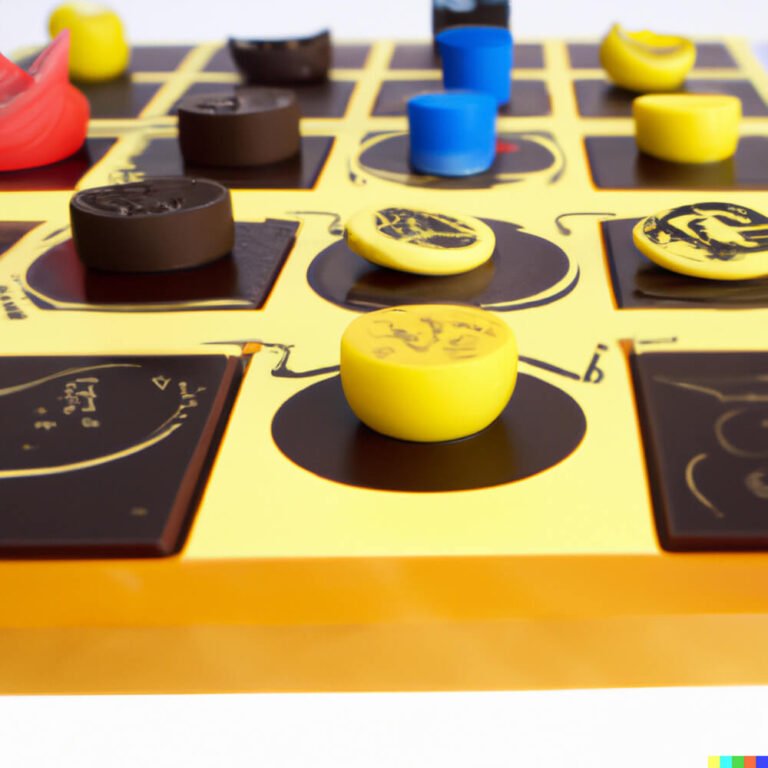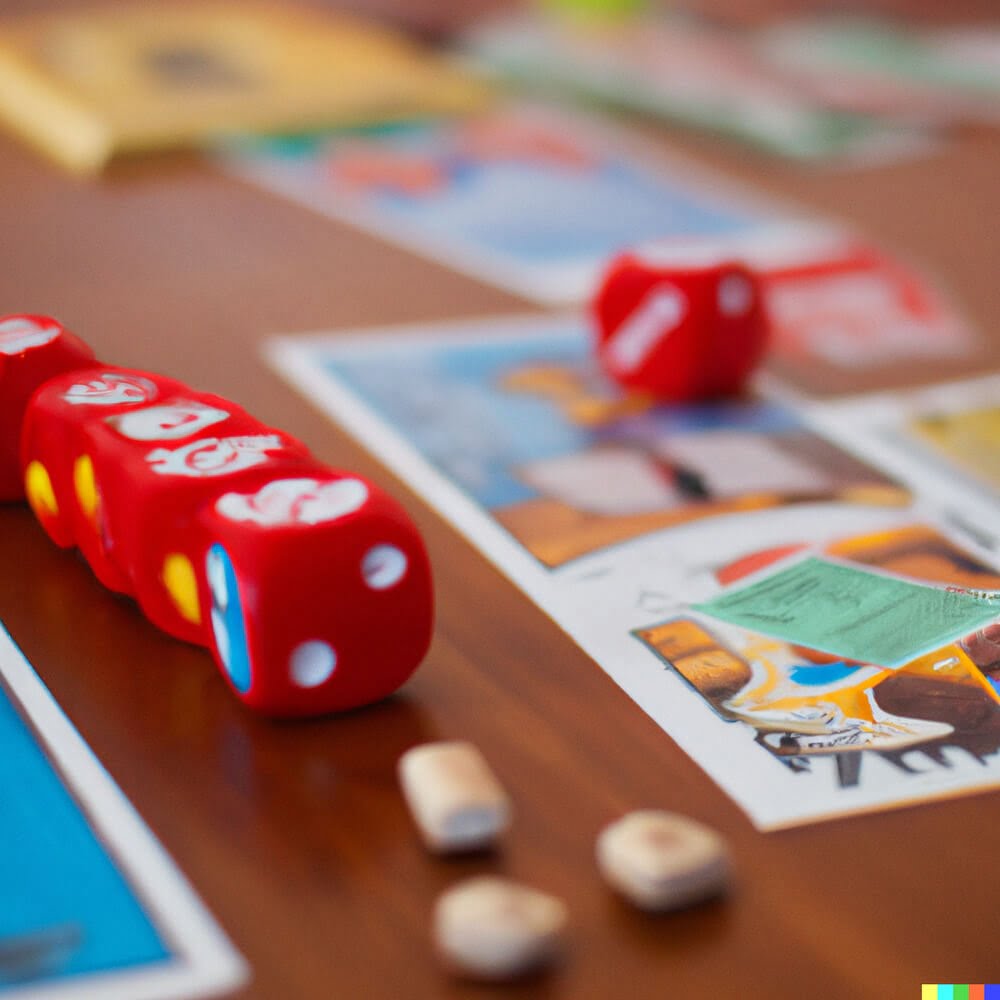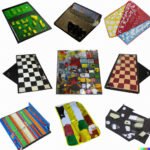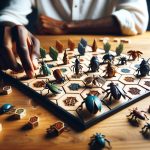The Hive Board Game is a highly strategic and competitive game that tests players’ tactical skills and decision-making abilities. With no board to confine the gameplay, this insect-themed game offers endless possibilities and opportunities for strategic maneuvering.
In Hive, players take turns placing and moving their insect pieces on the table, with the goal of surrounding their opponent’s Queen Bee while protecting their own. Each piece in the game has its own unique movement abilities, allowing for creative tactics and thoughtful planning.
To truly excel at Hive, it is essential to develop effective strategies that can adapt to different scenarios and opponents. From understanding the strengths and weaknesses of each piece to analyzing opening moves and maintaining a strong defense, having a well-thought-out strategy can be the key to success in this game.
By mastering control of the central area of the board, countering your opponent’s strategies, adapting to changing gameplay situations, and strategically navigating the endgame phase, players can become true Hive Masters. Throughout this article, we will explore various strategies that can help you improve your gameplay skills and become a formidable player in Hive.
Understanding the Hive Board Game Pieces
In order to develop effective strategies in the Hive board game, it is crucial to have a comprehensive understanding of the different pieces and their unique abilities. Each piece in Hive has its own set of rules and movements, making it essential to know how to utilize them effectively in different scenarios.
- The Queen Bee: The Queen Bee is the most important piece in Hive as it must be protected at all costs. It can only move one space at a time and cannot move through gaps or be blocked by other pieces. Understanding how to position and protect the Queen Bee is fundamental in winning the game.
- The Soldier Ant: Soldier Ants are versatile pieces that can move any number of spaces around the outside of the hive. They are considered to be the workhorses of your army, able to maneuver quickly and efficiently. Utilize Soldier Ants for various purposes such as creating connections with other pieces or blocking your opponent’s moves.
- The Grasshopper: Grasshoppers are powerful jumpers that can move over other pieces on the board, allowing them to rapidly change positions and create surprising attacks. Use Grasshoppers strategically to cut off your opponent’s path or disrupt their plans.
- The Beetle: Beetles have a unique ability where they crawl on top of other pieces, immobilizing both themselves and the piece beneath them until they are moved again. Use Beetles strategically by placing them on top of vulnerable enemy pieces or blocking an important movement for your opponent.
- The Spider: Spiders are another versatile piece that can move up to three spaces around the edge of the hive but cannot backtrack on its path within one turn. Spiders can be used for quick positioning or creating potential threats if placed strategically near key areas of interest.
By understanding each piece’s movement capabilities and leveraging their unique abilities, you will have a significant advantage in maneuvering and securing control over various positions on the board. Remember to assess your opponent’s piece combinations and adapt your strategy accordingly to counter their moves effectively.
Developing a Solid Opening Strategy
In order to set yourself up for success in the Hive Board Game, it is crucial to develop a strong opening strategy. The opening moves of the game can significantly impact the outcome and dictate the flow of the game. By understanding different opening strategies and their advantages, you can gain an early advantage over your opponent.
One popular opening strategy in Hive is known as the “Mosquito Opening.” This involves placing your Queen Bee adjacent to your opponent’s starting pieces, forcing them to make defensive moves rather than taking an offensive approach. By doing so, you are exerting control over the board and limiting your opponent’s options from the very beginning.
Another effective opening strategy is called the “Grasshopper Opening.” This entails using Grasshopper pieces to quickly move around and flank your opponent’s pieces, creating opportunities for strategic positioning and potential attacks on their vulnerable tiles. This strategy focuses on mobility and flexibility, allowing you to adapt to your opponent’s moves while also keeping them on their toes.
While these are just two examples, it is important to note that no single opening strategy will guarantee victory in every game. The key is to understand your own play style and choose an opening strategy that aligns with it. Additionally, it is crucial to anticipate your opponent’s potential responses and plan ahead accordingly.
To effectively develop a solid opening strategy in Hive, consider these tips:
- Study different opening strategies: Familiarize yourself with various tactics used by experienced players. Understand their reasoning behind each move and analyze how they position their pieces for maximum advantage.
- Plan ahead: Anticipate your opponent’s possible moves and think several steps ahead. Consider how each move will impact both immediate positioning and future opportunities.
- Utilize versatile pieces: Understand the unique abilities of each piece in Hive (such as Grasshoppers, Beetles, Ants) and use them strategically according to the situation at hand.
- Practice: The more you play and experiment with different opening strategies, the better you will become at identifying effective moves and adapting to various scenarios.
By developing a solid opening strategy in Hive, you can establish a strong foundation for the rest of the game. Remember to stay flexible and adjust your approach based on your opponent’s movements. With practice and strategic thinking, you’ll be well on your way to becoming a formidable player in Hive. Good luck.
Mastering Control of the Hive
Controlling the central area of the board is a crucial aspect of achieving victory in Hive. In this section, we will explore strategies for gaining and maintaining control over the hive, as well as techniques to effectively block your opponent’s pieces and restrict their movements.
Strategies for Controlling the Central Area
To gain control over the hive, it is essential to strategically position your pieces in a way that allows you to dominate the central area. Placing your pieces around the queen bee can provide a strong defensive position while also giving you more options for offensive moves. Additionally, spreading out your pieces throughout the board can help ensure that you have optimal mobility and flexibility in your gameplay.
Blocking Your Opponent’s Pieces
One effective technique for controlling the hive is to obstruct your opponent’s moves by blocking their pieces. By placing your own pieces strategically, you can limit their movements and force them into unfavorable positions. Pay close attention to potential weak spots in your opponent’s formation and exploit them by placing your piece adjacent to theirs, making it difficult for them to make meaningful moves.
Pinning and Surrounding Tactics
Another strategy for gaining control of the hive is through pinning and surrounding tactics. Pinning involves trapping an opponent’s piece between two or more of your own so that they become immobilized. Surrounding, on the other hand, entails encircling an opponent’s piece with your own pieces to restrict its mobility further. These tactics not only impede your opponent’s ability to move but also create opportunities for you to attack or defend other areas of the board.
By mastering these techniques, players can gain significant control over the hive, making it challenging for opponents to execute their strategies effectively. However, it is important to remember that controlling the hive should be done in conjunction with other strategic considerations such as protecting one’s queen bee and countering opponent’s moves effectively. The next section will explore strategies for countering your opponent’s tactics.
Countering Your Opponent’s Strategies
One of the key aspects of becoming a master at the Hive board game is the ability to adapt and counter your opponent’s strategies effectively. By understanding your opponent’s tactics and adjusting your gameplay accordingly, you can gain a significant advantage in the game. In this section, we will explore various strategies for countering your opponent’s moves and gaining positional advantage.
- Identifying Your Opponent’s Tactics: The first step in countering your opponent’s strategies is to identify their tactics. Pay close attention to their piece placements and the patterns they create on the board. Are they focusing on surrounding your pieces? Are they trying to isolate your Queen Bee? By understanding their approach, you can start planning on how to disrupt their plans.
- Breaking Through Defenses: Once you have identified your opponent’s strategy, it’s important to find ways to break through their defenses. Look for weaknesses or gaps in their arrangement of pieces. Is there an opportunity to create a chain reaction that would break down a defensive line? Can you isolate and capture one of their key pieces? By analyzing the board and finding these opportunities, you can start gaining an advantage.
- Knowing When to Attack Aggressively or Play Defensively: Another crucial aspect of countering your opponent’s strategies is knowing when to attack aggressively or play defensively. Sometimes, going on the offensive can catch your opponent off guard and force them into a reactive position.
Other times, it may be wiser to focus on protecting your own pieces and playing defensively until an opportunity presents itself. Assessing the current state of the game and anticipating potential outcomes will help guide your decision-making process.
Adapting and Flexibility in Gameplay
In order to succeed in the Hive Board Game, players must be able to adapt and adjust their strategies based on changing game situations and their opponent’s moves. Adapting and flexibility are crucial skills that will allow players to stay one step ahead, anticipate their opponent’s tactics, and make the most strategic decisions. This section will provide valuable insights and strategies on how to adapt and be flexible in gameplay.
One important aspect of adapting is being able to adjust your plan based on your opponent’s moves. Pay close attention to their actions and try to anticipate their next moves. This will help you identify any potential threats or opportunities that may arise. For example, if your opponent is focusing on controlling the center of the board, consider shifting your strategy towards gaining positional advantage elsewhere or find ways to break through their defenses.
Another strategy for adapting is to be mindful of different Hive piece combinations that you may encounter during gameplay. Different combinations can drastically change the dynamics of the game and require a shift in strategy. Familiarize yourself with various piece combinations and develop specific tactics for each one. For instance, if your opponent has a strong Beetle presence, focus on limiting its mobility or find ways to neutralize its threat.
Flexibility is also crucial when it comes to adjusting your defensive or offensive playstyle. Sometimes it may be necessary to switch between aggressive attacks or defensive maneuvers depending on the situation at hand. Assess whether it would be more beneficial to press your attack aggressively or play defensively, focusing on fortifying your pieces and protecting key pieces like the Queen Bee.
In summary, becoming a master of Hive requires players to possess adaptability and flexibility in their gameplay. Adapting involves adjusting your plan based on your opponent’s moves while flexibility allows you to switch between offensive and defensive strategies as needed. By honing these skills, players can maximize their chances of success in this strategic game.
| Adapting Strategies | Flexibility Techniques |
|---|---|
| – Anticipate opponent’s moves | – Switch between offensive and defensive strategies |
| – Identify threats and opportunities | – Adjust playstyle based on game situation |
| – Analyze piece combinations | – Focus on fortifying key pieces and protecting the Queen Bee |
Maintaining a Strong Defense
In the game of Hive, maintaining a strong defense is crucial to protect your Queen Bee and prevent your opponent from surrounding her. The Queen Bee is the most important piece in the game as she determines the winner, so it is essential to have a solid defense strategy to keep her safe. This section will provide strategies for protecting your Queen Bee, fortifying your pieces, and analyzing defensive moves such as trapping and evasion.
One effective way to maintain a strong defense is by strategically placing your pieces around the Queen Bee. By creating a barrier around her with other pieces like Beetles or Spiders, you make it harder for your opponent to reach her. Additionally, positioning these pieces strategically can also block off potential pathways for your opponent’s pieces.
Trapping is another defensive move that can be used to immobilize your opponent’s pieces and restrict their movements. Trapping involves positioning one of your pieces next to an opponent’s piece in such a way that it cannot move without breaking its own connection. This tactic can be especially useful when applied to key pieces like the Spider or Grasshopper.
Evasion is another defensive strategy that involves maneuvering your pieces away from potential threats. By moving your important pieces like the Queen Bee or Spider out of harm’s way, you can prevent them from being easily surrounded by your opponent. However, it’s important to note that while evasion can be effective in certain situations, overusing it may result in losing control over the board.
| Defense Strategies | Description |
|---|---|
| Positioning Barrier Pieces | Create a protective barrier around the Queen Bee using other pieces. |
| Trapping | Immoblize opponent’s pieces by positioning yours in a way that restricts their movement. |
| Evasion | Move important pieces away from potential threats to prevent them from being surrounded. |
Endgame Tactics and Calculated Risks
As the game progresses towards its conclusion, the endgame phase in Hive becomes crucial. This is the time where players must carefully analyze the board state and make calculated risks to secure a victory. In this section, we will explore strategies that can be employed during the endgame phase of Hive.
One important strategy in the endgame is to focus on securing a strong position for your Queen Bee. Since the Queen Bee must always be surrounded by at least one piece, protecting her becomes paramount. Look for opportunities to reinforce her position by placing additional pieces adjacent to her. This not only provides additional defense but also restricts your opponent’s movement options.
Calculating risks and making sacrifices can also play a pivotal role in the endgame. Sometimes, sacrificing one of your own pieces strategically can create an advantage or foil your opponent’s plans. For example, if you notice your opponent setting up for a surround on your Queen Bee, sacrificing another piece nearby can disrupt their plan and force them to readjust their strategy.
Another key aspect of endgame tactics is reading your opponent’s moves and anticipating their next move accurately. By studying their patterns throughout the game, you can predict where they might try to move next. Use this information to strategize your own moves accordingly – either by blocking their possible paths or setting up traps to catch their pieces off-guard.
It is important to stay vigilant and avoid common pitfalls during the endgame as well. Carefully consider each move you make as it could have long-lasting effects on the outcome of the game. Avoid making rash moves out of desperation, as that can often lead to fatal mistakes. Instead, take your time, calculate risks, and make each move with purpose.
By employing these endgame strategies and taking calculated risks when necessary, you increase your chances of securing a victory in Hive. Remember that practice makes perfect – refining these tactics through experience will ultimately make you a formidable opponent in the game of Hive.
Conclusion
In conclusion, developing effective strategies is key to becoming a Hive master. Throughout this article, we have explored various aspects of the game and discussed strategies for different stages of gameplay. Understanding the unique abilities of each piece and utilizing them effectively is crucial in gaining an advantage over your opponent.
A strong opening move sets the tone for the rest of the game, so it is important to plan ahead and anticipate your opponent’s moves. Taking control of the central area of the board and strategically blocking your opponent’s pieces can give you a significant advantage. It is also essential to adapt and adjust your strategy based on your opponent’s tactics.
Maintaining a strong defense, protecting your Queen Bee, and fortifying your pieces are crucial defensive strategies that can help you withstand attacks from your opponent. In the endgame phase, calculated risks and sacrifices may be necessary to secure victory.
To become a formidable opponent in Hive, it is essential to practice and refine your skills. By studying different piece combinations and analyzing various strategies, you can increase your chances of success. The strategic depth and rewarding gameplay experience offered by Hive make it a game worth investing time and effort into mastering.
Frequently Asked Questions
How do I get better at Hive?
To get better at Hive, it’s important to practice regularly and familiarize yourself with the different pieces and their abilities. A good way to start is by understanding the basic rules and objectives of the game. Once you have a grasp on these fundamentals, focus on developing your strategic thinking skills.
Try to anticipate your opponent’s moves and plan ahead accordingly. It can also be helpful to analyze and learn from your previous games, identifying areas where you made mistakes or missed opportunities. Additionally, playing against opponents of varying skill levels can help challenge you and expose you to different strategies.
What is the best starting piece for Hive?
When it comes to determining the best starting piece in Hive, there isn’t a universally agreed-upon answer as each player may have their preferred approach based on their own playing style. The most commonly favored starting pieces are typically the Queen Bee or the Beetle. The Queen Bee, being the only piece that cannot be placed after a certain point in the game, is often chosen for its strategic importance.
Playing it early allows for greater flexibility in board positioning later on. On the other hand, some players prefer to start with the Beetle since it has versatile movement capabilities that can provide various tactical advantages.
What is the black strategy in Hive?
The black strategy in Hive revolves around maintaining tight control over the game board while forcing your opponent into tricky situations where they find it difficult to make optimal moves. As black begins second, they have an opportunity to react and adapt their tactics based on white’s opening moves. One strategy involves using your initial pieces effectively by spreading them out across different spots on the board instead of clustering them close together.
This provides more mobility options for future turns and makes it harder for your opponent to encircle or trap your pieces. Additionally, keeping a strong defense is key – preventing your opponent from surrounding your valuable pieces like the Queen Bee can give you an advantage in later stages of the game when resources become limited. Overall, being patient yet proactive in developing your pieces while disrupting your opponent’s plans can contribute to a successful black strategy in Hive.

I love playing all kinds of games – from classics like Monopoly to modern favourites like Ticket to Ride.
I created this blog as a way to share my love of board games with others, and provide information on the latest releases and news in the industry.





